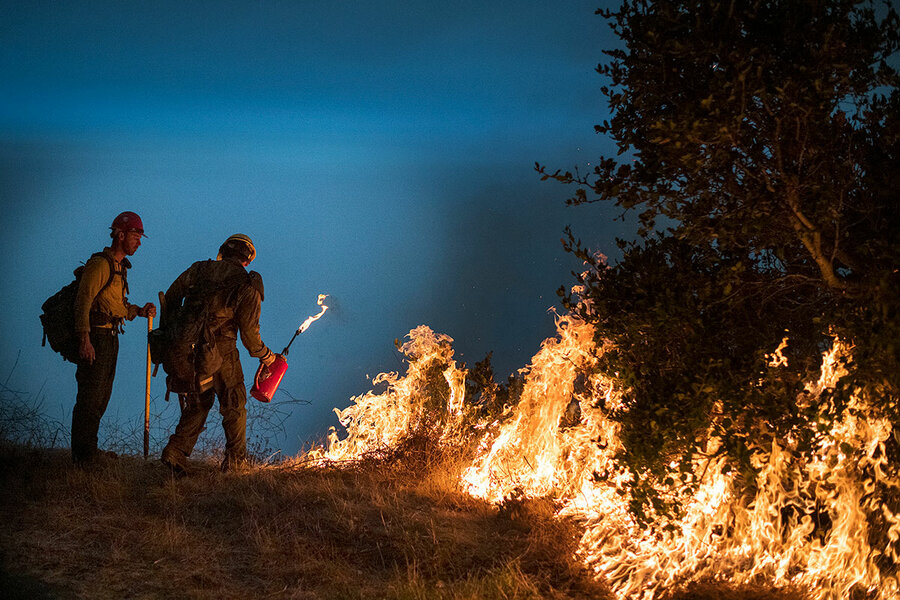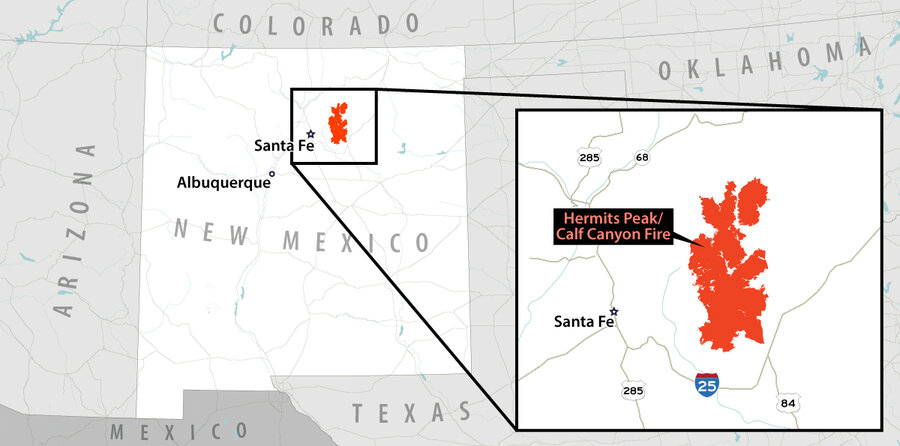Prescribed fires: Why they’re still trusted despite runaway blaze
Loading...
The bear clad in a ranger hat and jeans has stood the test of time. Introduced during World War II, Smokey Bear still reminds Americans that “only you” can prevent wildfires, finger-pointing à la Uncle Sam.
But many forest and fire experts see a role for periodically starting a controlled or prescribed burn. Also called “good fire,” these terms refer to regulated burning for land management goals. On private or public land, prescribed fire can be used to enhance the health of ecosystems by burning off buildups of vegetation – or “fuels” – and thereby lowering the risk of severe wildfire. In an era of increasingly frequent and larger wildfires linked in part to climate change, fire ecologists say it’s a mitigation measure to trust.
“Prescribed fire is one of our best tools,” says fire ecologist Susan Prichard, a research scientist at the University of Washington.
Why We Wrote This
A story focused onTwo planned burns that went wrong in New Mexico led to a record blaze this spring, but that’s rare. Prescribed fire is widely considered a trusted tool for wildfire prevention.
This year, however, New Mexico is home to a record-setting wildfire resulting from two different prescribed burns overseen by the federal government. That has inflected discussions around the practice and resulted in a pause that some experts argue could actually hamper wildfire prevention.
Intentional ignition may not seem to square with Smokey’s avoidance approach, but the two strategies have a tangled history.
What’s the evidence that prescribed fire curbs wildfires?
Research supports the effectiveness of fuel treatments like prescribed fire – especially when combined with “thinning,” such as tree-cutting to reduce forest density, which some find controversial.
Many experts argue that more than a century of fire exclusion – including the loss of Indigenous burning as well as fire suppression – has actually made lands more prone to wildfire.
The federal government began to shift away from suppression as policy in the 1960s, says fire historian Stephen Pyne, but the practical application of it has been gradual. Prescribed fire has widest use in the Southeast, where Florida, an early adopter, has lowered legal liability for landowners who set controlled burns. Proponents call for increased use of this treatment in drought-wracked Western states. But because the West holds a greater share of public lands, expansion would likely involve federal agencies, which have agreed to ramp up this approach.
Prescribed-fire fans tout a record of security. Figures from the U.S. Forest Service, which runs the largest federal prescribed fire program, indicate its burns rarely go off the rails. Out of 86,571 fires ignited by USFS between 2003 and 2021, the agency counts 128 that were declared wildfires – often called “escapes.” That’s less than 1%.
And yet, escapes make headlines.
How did fire in New Mexico put a pause on certain prescribed burns nationally?
With 93% of its perimeter now contained, the Hermits Peak/Calf Canyon Fire that started in New Mexico this spring has spanned over 340,000 acres. Size-wise, it’s the largest fire in recorded state history. And it was caused by the merging of blazes that resulted from two prescribed burns overseen by USFS that didn’t go as planned.
Facing frustration from residents and politicians, and citing “extreme wildfire risk conditions,” U.S. Forest Service Chief Randy Moore on May 20 announced a 90-day pause on prescribed fire operations on national forest lands as the agency reviews “protocols, decision support tools and practices.” A report on the origins of the Hermits Peak Fire includes a major takeaway echoed by ecologists: the need to better adapt to complex conditions.
“Fires are outpacing our models. ... We need to better understand how megadrought and climate change are affecting our actions on the ground,” Chief Moore said in the report.
This isn’t the first time federal officials have publicly atoned for poor prescribed burn planning after escapes. The current pause has drawn critics, and the Association for Fire Ecology, where Dr. Prichard serves on the board, has called for a reconsideration so that prescribed fire can continue “where safe.” Still, she says she appreciates the USFS’s commitment to “adaptive management.”
“That’s like making a mistake and learning from it, and then adapting your work to hopefully do better next time,” says the fire ecologist.
The full impact is unclear. Asked how many prescribed fire operations on National Forest System lands were canceled due to the pause, USFS spokesperson Michelle Burnett stated in an email, “It is very difficult to estimate how many prescribed fire operations have been impacted,” in part because several conditions, including weather, must be met for a planned fire to move forward. It’s also not peak season for USFS prescribed fires, over 90% of which the agency says take place between September and May.
What can be done to sustain public trust in fighting fire with fire?
Prescribed burning won’t eliminate wildfires on its own, and experts say it’s important for messengers – agencies, scientists, journalists – to highlight not just benefits but also risks. Beyond escapes, those include potential air quality and health impacts from prescribed fire.
“I think the best approach on trust is to take people out to sites and show them what you’re doing, and why, and what the consequences of not doing it may be,” says Dr. Pyne, a professor emeritus at Arizona State University. That supports research that found familiarity with such land management was a key factor in public approval, as was understanding ecological benefits.
It helps to recall that fire-lighting has been a constant fact of human evolution. In the fire historian’s words: “This is what we do that no other creature does.”







